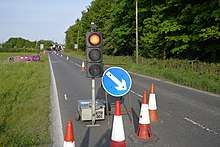Traffic light
Traffic lights, traffic signals, stoplights or robots are signalling devices positioned at road intersections, pedestrian crossings, and other locations to control flows of traffic.[1]
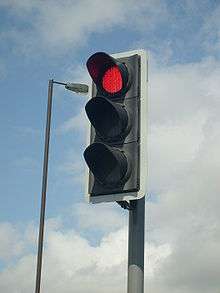
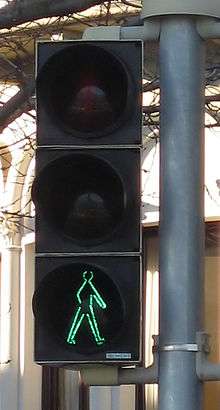
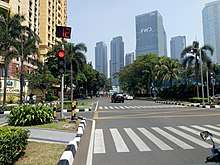
The world's first traffic light was a manually operated gas-lit signal installed in London in December 1868. It exploded less than a month after it was implemented, injuring its policeman operator.[2] Earnest Sirrine from Chicago patented the first automated traffic control system in 1910. It used the words "STOP" and "PROCEED", although neither word was illuminated.[3]
Traffic lights follow a universal colour code which alternates the right of way accorded to users with a sequence of illuminating lamps or LEDs of three standard colours:
- Green light
Allows traffic to proceed in the direction denoted, if it is safe to do so and there is room on the other side of the intersection. The green light was traditionally green in colour[4] (hence its name) though modern LED green lights are turquoise[5][6].
- Red light
Prohibits any traffic from proceeding. A flashing red indication requires traffic to stop and then proceed when safe (equivalent to a stop sign).
- Amber light (also known as 'yellow light')
Warns that the signal is about to change to red, with some jurisdictions requiring drivers to stop if it is safe to do so, and others allowing drivers to go through the intersection if safe to do so. In some European countries (such as the UK), red and amber is displayed together, indicating that the signal is about to change to green.[7]
A flashing amber indication is a warning signal. In the United Kingdom, a flashing amber light is used only at pelican crossings, in place of the combined red–amber signal, and indicates that drivers may pass if no pedestrians are on the crossing.
In some countries traffic signals will go into a flashing mode if the conflict monitor detects a problem, such as a fault that tries to display green lights to conflicting traffic. The signal may display flashing amber to the main road and flashing red to the side road, or flashing red in all directions. Flashing operation can also be used during times of day when traffic is light, such as late at night.[8]
History

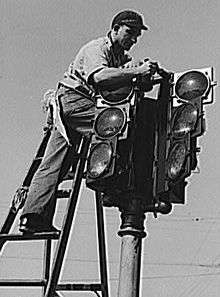
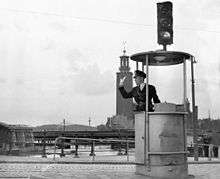
Before traffic lights, traffic police controlled the flow of traffic. A well-documented example is that on London Bridge in 1722.[9] Three men were given the task of directing traffic coming in and out of either London or Southwark. Each officer would help direct traffic coming out of Southwark into London and he made sure all traffic stayed on the west end of the bridge. A second officer would direct traffic on the east end of the bridge to control the flow of people leaving London and going into Southwark.
On 9 December 1868,[10] the first non-electric gas-lit traffic lights were installed outside the Houses of Parliament in London to control the traffic in Bridge Street, Great George Street, and Parliament Street.[11] They were proposed by the railway engineer J. P. Knight of Nottingham who had adapted this idea from his design of railway signalling systems[12] and constructed by the railway signal engineers of Saxby & Farmer. The main reason for the traffic light was that there was an overflow of horse-drawn traffic over Westminster Bridge which forced thousands of pedestrians to walk next to the Houses of Parliament.[13] The design combined three semaphore arms with red and green gas lamps for night-time use, on a pillar, operated by a police constable. The gas lantern was manually turned by a traffic police officer with a lever at its base so that the appropriate light faced traffic.[14] The signal was 22 feet (6.7 m) high. The light was called the semaphore and had arms that would extend horizontally that commanded drivers to "Stop" and then the arms would lower to a 45 degrees angle to tell drivers to proceed with "Caution". At night a red light would command "Stop" and a green light would mean use "Caution".[9]
Although it was said to be successful at controlling traffic, its operational life was brief. It exploded on 2 January 1869 as a result of a leak in one of the gas lines underneath the pavement[15] and injured the policeman who was operating it.[16]
20th Century
In the first two decades of the 20th century, semaphore traffic signals like the one in London were in use all over the United States with each state having its own design of the device. One example was from Toledo, Ohio in 1908. The words "Stop" and "Go" were in white on a green background and the lights had red and green lenses illuminated by kerosene lamps for night travelers and the arms were 8 feet (2.4 m) above ground.[17] It was controlled by a traffic officer who would blow a whistle before changing the commands on this signal to help alert travelers of the change. The design was also used in Philadelphia and Detroit.[18] The example in Ohio was the first time America tried to use a more visible form of traffic control that evolved the use of semaphore. The device that was used in Ohio was designed based on the use of railroad signals.[19]
In 1912, a traffic control device was placed on top of a tower in Paris at the intersection of rue Montmartre and the boulevard Montmartre. This tower signal was manned by a policewoman and she operated a revolving four-sided metal box on top of a glass showcase where the word "Stop" was painted in red and the word "Go" painted in white.[20]
Electric
An electric traffic light was developed in 1912 by Lester Wire, a policeman in Salt Lake City, Utah, who also used red-green lights.[21] On 5 August 1914, the American Traffic Signal Company installed a traffic signal system on the corner of East 105th Street and Euclid Avenue in Cleveland, Ohio.[22][23] It had two colours, red and green, and a buzzer, based on the design of James Hoge, to provide a warning for colour changes. The design by James Hoge[24] allowed police and fire stations to control the signals in case of emergency. The first four-way, three-colour traffic light was created by police officer William Potts in Detroit, Michigan in 1920.[25] Ashville, Ohio claims to be the home of the oldest working traffic light in the United States, used at an intersection of public roads from 1932 to 1982 when it was moved to a local museum.[26][27] Many pictures of historical traffic lights appear at a Traffic Signal Trivia page.[28]
The tower was the first innovation that used the three-coloured traffic signal and appeared first in the City of Detroit, where the first three-coloured traffic light was built at the intersection of Michigan and Woodward Avenues in 1920. The man behind this three-colour traffic light was police officer William Potts of Detroit. He was concerned about how police officers at four different lights signals could not change their lights all at the same time. The answer was a third light that was coloured amber, which was the same colour used on the railroad.[13] Potts also placed a timer with the light to help coordinate a four-way set of lights in the city. The traffic tower soon used twelve floodlights to control traffic and the reason for a tower in the first place was that at the time the intersection was one of the busiest in the world, with over 20,000 vehicles daily.[29]
Los Angeles installed its first automated traffic signals in October 1920 at five locations on Broadway. These early signals, manufactured by the Acme Traffic Signal Co., paired "Stop" and "Go" semaphore arms with small red and green lights. Bells played the role of today's amber lights, ringing when the flags changed—a process that took five seconds. By 1923 the city had installed 31 Acme traffic control devices.[30] The Acme semaphore traffic lights were often used in Warner Bros. Looney Tunes and Merrie Melodies cartoons for comedic effect due to their loud bell.
The first interconnected traffic signal system was installed in Salt Lake City in 1917, with six connected intersections controlled simultaneously from a manual switch.[31] Automatic control of interconnected traffic lights was introduced March 1922 in Houston, Texas.[32]
In 1922 traffic towers were beginning to be controlled by automatic timers. The first company to add timers in traffic lights was Crouse Hinds. They built railroad signals and were the first company to place timers in traffic lights in Houston, which was their home city.[33] The main advantage for the use of the timer was that it saved cities money by replacing traffic officers. The city of New York was able to reassign all but 500 of its 6,000 officers working on the traffic squad; this saved the city $12,500,000.[33]
After witnessing an accident between an automobile and a horse-drawn carriage, African American inventor, Garrett Morgan, filed a U.S. patent for a traffic signal.[34] Patent No. 1,475,024[35] was granted on 20 November 1923 for Morgan's three-position traffic signal.
The first traffic lights in Britain were deployed in Piccadilly Circus in 1926.[36] Wolverhampton was the first British town to introduce automated traffic lights in 1927 in Princes Square at the junction of Lichfield Street and Princess Street.[37]
Melbourne was the first city in Australia to install traffic lights in 1928 on the intersection of Collins and Swanston Street.
The twelve-light system did not become available until 1928 and another feature of the light system was that hoods were placed over the light and each lens was sand-blasted to increase daytime visibility.[38]
Both the tower and semaphores were phased out by 1930. Towers were too big and obstructed traffic; semaphores were too small and drivers could not see them at night.[39]
The first traffic light in South India was installed at Egmore Junction, Chennai in 1953. The city of Bangalore installed its first traffic light at Corporation Circle in 1963.[40]
The control of traffic lights made a big turn with the rise of computers in America in the 1950s.
Thanks to computers, the changing of lights made Crosby's flow even quicker thanks to computerized detection. A pressure plate was placed at intersections so once a car was on the plate computers would know that a car was waiting at the red light.[41] Some of this detection included knowing the number of waiting cars against the red light and the length of time waited by the first vehicle at the red.[42] One of the best historical examples of computerized control of lights was in Denver in 1952. One computer took control of 120 lights with six pressure-sensitive detectors measuring inbound and outbound traffic. The system was in place at the central business district, where the most traffic was between the downtown area and the north and northeastern parts of the city. The control room that housed the computer in charge of the system was in the basement of the City and County Building.[42] As computers started to evolve, traffic light control also improved and became easier. In 1967, the city of Toronto was the first to use more advanced computers that were better at vehicle detection.[42] Thanks to the new and better computers traffic flow moved even quicker than with the use of the tower. The computers maintained control over 159 signals in the cities through telephone lines. People praised the computers for their detection abilities. Thanks to detection computers could change the length of the green light based on the volume of waiting cars.[43] The rise of computers is the model of traffic control which is now used in the 21st century.
Countdown timers on traffic lights were introduced in the 1990s. Timers are useful for pedestrians, to plan whether there is enough time to cross the intersection before the end of the walk phase, and for drivers, to know the amount of time before the light switches. In the United States, timers for vehicle traffic are prohibited, but pedestrian timers are now required on new or upgraded signals on wider roadways. In some cities, including Philadelphia, pedestrian timers can be used by motorists as well to know how much time remains in the green cycle, because when the pedestrian timer reaches zero, the signal will simultaneously turn amber.
Types and placement of colours
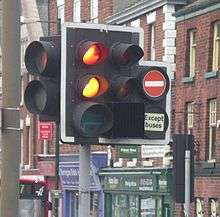
A typical vertical traffic signal has three aspects, or lights, facing the oncoming traffic, red on top, amber below, and green below that. Generally one aspect is illuminated at a time. In some cases, a fourth aspect, for a turn arrow for example, is below the three lights or aspects in more complicated road traffic intersections.
Single aspects
The simplest traffic light comprises either a single or a pair of coloured aspects that warns any user of the shared right of way of a possible conflict or danger.
- Flashing red: treated as a stop sign. This can also signal the road is closed. In France and the United Kingdom, flashing red mandates absolute stop, at the crossing of a railway line, an airport strip, a swing bridge, or a fire station.
- Flashing amber: caution, crossing or road hazard ahead.
- Flashing green: varies among jurisdiction. Flashing green can give permission to go straight as well as make a left turn in front of opposing traffic (which is stopped by a steady red light), can indicate the end of a green cycle before the light changes to a steady amber, or (as in British Columbia, Canada, or Mexico City, Mexico) indicates the intersection is a pedestrian crosswalk.
In the United States, flashing red or amber lights, known as intersection control beacons, are used to reinforce stop signs at intersections.[44]
Dual aspects
These have two lights, usually mounted vertically. They are often seen at railway crossings, fire stations, and intersections of streets. They flash amber or white when cross traffic is not expected, and turn red to stop traffic when cross traffic occurs (e.g., the fire engines are about to exit the station). They are also sometimes used for ramp metering, where motorists enter a controlled-access highway during heavy traffic. Usually, only one vehicle on the ramp proceeds when the signal shows green. Two or three per green are allowed in some cases.
Three or more aspects & positioning of aspects
The standard traffic signal is the red light above the green, with amber between.
When the traffic signal with three aspects is arranged horizontally or sideways, the arrangement depends on the rule of the road. In right-lane countries, the sequence (from left to right) is red–amber–green. In left-lane countries, the sequence is green–amber–red.
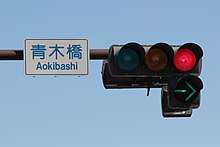
Other signals are sometimes added for more control, such as for public transportation and right or left turns allowed only when the green arrow is illuminated or specifically prohibited if the red arrow is illuminated.
Traffic signal cycles
Generally, at least one direction of traffic at an intersection has the green lights (green aspect) at any moment in the cycle. In some jurisdictions, for a brief time, all signals at an intersection show red at the same time, to clear any traffic in the intersection. The delay can depend on traffic, road conditions, the physical layout of the intersection, and legal requirements. Thus modern signals are built to allow the "all red" in an intersection, even if the feature is not used.
Some signals have no "all red" phase: the light turns green for cross traffic the instant the other light turns red.[note 1]
Another variant in some locations is the pedestrian scramble, where all the traffic lights for vehicles become red, and pedestrians are allowed to walk freely, even diagonally, across the intersection.
Variations
In the Canadian province of Quebec and the Maritime provinces, lights are often arranged horizontally, but each aspect is a different shape: red is a square (larger than the normal circle) and usually in pairs at either end of the fixture, amber is a diamond, and green is a circle. In many southern and southwestern U.S. states, most traffic signals are similarly horizontal in order to ease wind resistance during storms and hurricanes.[45]
Japanese traffic signals mostly follow the same rule except that the "go" signals are referred to as 青 (blue), which they historically were in fact, but this caused complications with the international "green for go" rule, so [46] in 1973 a decree was issued that the "go" light should be changed to the bluest possible hue of green, thus making it factually greener without having to change the name from 青(blue) to 緑(green).
In Britain, and much of Europe, normal traffic lights follow this sequence:[47]
- Red – Stop, do not proceed
- Red and Amber - Get ready to proceed, but do not proceed yet
- Green – Proceed if the intersection or crossing is clear, you are not allowed to block the intersection or crossing
- Amber - Stop, only if it is safe to do so.
Use of traffic signals in waterways, on railroads for rail traffic
The three-aspect standard is also used at locks on the Upper Mississippi River. Red means that another vessel is passing through. Amber means that the lock chamber is being emptied or filled to match the level of the approaching vessel. After the gate opens, green means that the vessel may enter.
Railroad signals, for stopping trains in their own right of way, use the opposite positioning of the colours; the two types cannot be confused. That is, green on top and red below is the standard placement of the signal colours on railroad tracks.
Pedestrian and cyclist crossing lights
Australia and New Zealand
In Australia and New Zealand, the light sequence is :
- Green man: safe to cross the intersection
- Flashing red man: continue to cross if already in the intersection, but do not start to cross
- Red man: do not cross
Some traffic lights in the capital cities (e.g. Sydney, Melbourne, Brisbane, Perth and Adelaide) have countdown timers for pedestrian crossing lights, usually a countdown from 30 when the red flashing man appeared. Countdown timers have been installed on some pedestrian crossing lights in Auckland and Christchurch counting down from 15 seconds.
Some traffic-light controlled junctions have a light sequence that stops all vehicular traffic at the junction at the same time, and gives pedestrians exclusive access to the intersection so that they can cross in any direction (including diagonally). This is prominently featured in the Sydney CBD outside Town Hall, and other pedestrian-heavy locations, such as in Redfern near the University of Sydney. This is known as a pedestrian scramble or Barnes Dance in some places. In New Zealand such pedestrian crossings can be found in the central business district (CBD) of Auckland, Wellington, Christchurch and Dunedin.
The Barnes Dance is named after an American traffic engineer, Henry A. Barnes. Barnes did not claim to have invented the system but was a strong advocate of it, having observed the difficulties his daughter faced crossing the road to get to school.[48]
Several intersections in Wellington, New Zealand, have alternative green man figures. Eight intersections near Parliament Buildings have silhouettes of suffragette Kate Sheppard,[49] while four intersections along Cuba Street have silhouettes of drag performer and LGBT rights activist Carmen Rupe.[50]
Asia
Chinese light sequence is:
- Green: safe to cross.
- Red: do not cross.
- Amber (steady, after green, before red): continue to cross only if unable to stop safely.
- Flashing amber: cross with caution (often used in low-traffic crossing or after midnight).
Japanese light sequence is:
- Blue: safe to cross
- Amber: cross only if it is safe
- Red: do not cross
For more information on the situation in Japan, please see 日本の音響装置付信号機 (in Japanese).
Europe
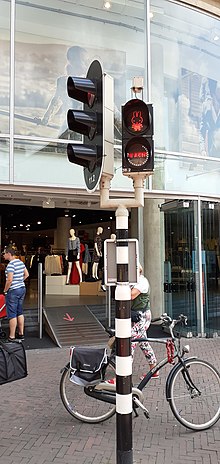
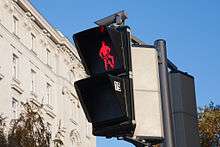
The European approach to a signalized crossing is to use dual or, more rarely, a triple aspect[51] with a blackened out lens of a pictogram pedestrian. For cyclists, the same approach is used, with the lens blackened out for a bicycle frame. It is not uncommon to see lenses with both symbols on them. Most European countries use orange instead of amber for the middle light.
The light sequence is:
- Green: safe to cross.
- Amber: continue to cross only if unable to stop safely.
- Flashing amber: cross with caution (often used when lights are out of order or shut down).
- Red: do not cross.
In Germany, the Czech Republic and some other Central European countries, a combination of red and orange lights is illuminated just before the green phase. The light sequence is as follows:
- Green: safe to cross.
- Orange: continue to cross only if unable to stop safely.
- Flashing orange: cross with caution, obey signage (used when lights are out of order or shut down).
- Red: do not cross.
- Red and orange: do not cross, prepare for green.
The light is blackened out with a pedestrian pictogram.
Ampelmännchen pedestrian traffic signals have come to be seen as a nostalgic sign for the former German Democratic Republic. In Germany the fine for crossing a red light if caught is as of 2019 between €5 and €10.[52]
In the United Kingdom, Ireland, British Crown dependencies and dependent territories, and former possessions like Hong Kong two or more of the following signals are displayed to pedestrians -
- A still image of a green walking person: cross the road
- Flashing green walking person: continue to cross if already on the crossing but do not start to cross. Some signals use an amber numerical countdown display, instead of the flashing green man, indicating to pedestrians the time remaining to cross the road.[53]
- Red standing man: do not cross/do not start to cross
In the United Kingdom there is no direct offence committed if a pedestrian fails to obey crossing signals and many lights commonly only use two still images - a green walking person and a red standing man, this being the general case where the crossing is at a road junction and the pedestrian signals are in combination with those controlling vehicular traffic. Flashing amber lights and images at pedestrian crossings are used where the vehicular traffic lights perform the sole function of stopping road traffic to allow pedestrians to cross a road.
The same system is used also in Switzerland, Hong Kong and Macau.
North America
In the United States, the most common aspect is the written 'walk' or 'don't walk.' In Canada, the white walking person is almost always used. Increasingly for retrofits of dual aspects and newer installations, the lower aspect formerly used for the "walk" signal (a walking person) is being replaced with a timer countdown. The raised hand pictogram first appeared in the city of Westmount, Montreal, and was invented by Alexander Heron, having observed a policeman's gloved hand controlling a crossing.
The light sequence is:
- Green, blue, or white walking person or "walk": cross with caution (pedestrians have the right of way; motorists turning left or right must yield to pedestrians).
- Flashing red or orange stop hand or "don't walk": do not start crossing, but continue if already in the middle of the intersection.
- Red or orange stop hand or "don't walk": do not enter the intersection.
The U.S. state of Massachusetts allows an unusual indication variation for pedestrian movement. At signalized intersections without separate pedestrian signal heads, the traffic signals may be programmed to turn red in all directions, followed by a steady display of amber lights simultaneously with the red indications. During this red-plus-amber indication, the intersection is closed to vehicular traffic and pedestrians may cross, usually in whatever direction they choose (this is known as a "Barnes dance").
Auditory and tactile signals for impaired people
In some jurisdictions such as Australia, New Zealand, and Ireland pedestrian lights are associated with a sound device, for the benefit of blind and visually impaired pedestrians. These make a slow beeping sound when the pedestrian lights are red and a continuous buzzing sound when the lights are green. In the Australian States of Queensland, New South Wales, Victoria and Western Australia, the sound is produced in the same unit as the push buttons. This system of assistive technology is also widely used at busy intersections in Canadian cities.
In the United Kingdom, the Puffin crossings and their predecessor, the Pelican crossing, will make a fast beeping sound to indicate that it is safe to cross the road. The beeping sound is disabled during the night time so as not to disturb any nearby residents.[54]
In some states in the United States, at some busy intersections, buttons will make a beeping sound for blind people. When the light changes, a speaker built into the button will play a recording to notify blind people that it is safe to cross. When the signal flashes red, the recording will start to count down with the countdown timer.
In several countries such as New Zealand, technology also allows deaf and blind people to feel when lights have changed to allow safe crossing. A small pad, housed within an indentation in the base of box housing the button mechanism, moves downwards when the lights change to allow crossing. This is designed to be felt by anyone waiting to cross who has limited ability to detect sight or sound.
Lights for public transport
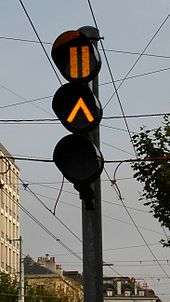
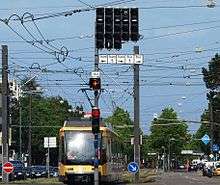
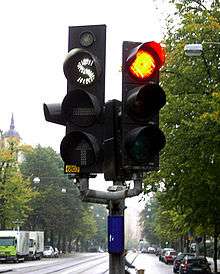
Traffic lights for public transport often use signals that are distinct from those for private traffic. They can be letters, arrows or bars of white or coloured light.
In Portland, Oregon, the tram signals feature an orange horizontal bar and a white vertical bar. Some systems use the letter B for buses, and T for trams.
In some European countries and Russia, dedicated traffic signals for public transport (tram, as well any that is using a dedicated lane) have four white lights that form the letter T. If the three top lamps are lit, this means "stop". If the bottom lamp and some lamps on the top row are lit, this means permission to go in a direction shown. In case of a tram signal, if there are no tram junctions or turns on an intersection, a simpler system of one amber signal in the form of letter T is used instead; the tram must proceed only when the signal is lit.
In North European countries, the tram signals feature white lights of different forms: "S" for "stop", "—" for "caution" and arrows to permit passage in a given direction.[55]
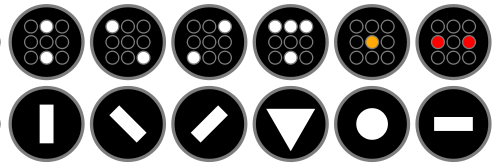
The Netherlands use a distinctive "negenoog" (nine-eyed) design shown on the top row of the diagram;[56] bottom row signals are used in Belgium, Luxembourg, France and Germany. The signals mean (from left to right): "go straight ahead", "go left", "go right", "go in any direction" (like the "green" of a normal traffic light), "stop, unless the emergency brake is needed" (equal to "amber"), and "stop" (equal to "red").
The METRO light rail system in Minneapolis, Minnesota, the Valley Metro Rail in Phoenix, Arizona, and the RTA Streetcar System in New Orleans use a simplified variant of the Belgian/French system in the respective city's central business district where only the "go" and "stop" configurations are used. A third signal equal to amber is accomplished by flashing the "go" signal.
In Japan, tram signals are under the regular vehicle signal; however, the colour of the signal intended for trams is orange.
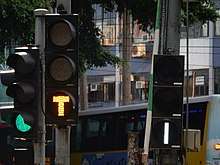
In Hong Kong Island, Hong Kong, an amber T-signal is used for trams, in place of the green signal. Addition to that, at any tramway junction, another set of signals is available to indicate the direction of the tracks.
In Australia and New Zealand, a white "B" or "T" sometimes replaces the green light indicating that buses or trams (respectively) have right of way.
Preemption and priority
Some regions have signals that are interruptible, giving priority to special traffic usually emergency vehicles such as fire apparatus, ambulances, and police squad cars.[57][58] Most of the systems operate with small transmitters that send radio waves, infrared signals, or strobe light signals that are received by a sensor on or near the traffic lights. Some systems use audio detection, where a certain type of siren must be used and detected by a receiver on the traffic light structure.
Upon activation, the normal traffic light cycle is suspended and replaced by the "preemption sequence": the traffic lights to all approaches to the intersection are switched to "red" with the exception of the light for the vehicle that has triggered the preemption sequence. Sometimes, an additional signal light is placed nearby to indicate to the preempting vehicle that the preempting sequence has been activated and to warn other motorists of the approach of an emergency vehicle. The normal traffic light cycle resumes after the sensor has been passed by the vehicle that triggered the preemption.
In lieu of preemptive mechanisms, in most jurisdictions, emergency vehicles are not required to respect traffic lights. However, emergency vehicles must slow down, proceed cautiously and activate their emergency lights to alert oncoming drivers to the preemption when crossing an intersection against the light.[59][60]
Unlike preemption, which immediately interrupts a signal's normal operation to serve the preempting vehicle and is usually reserved for emergency use, "priority" is a set of strategies intended to reduce delay for specific vehicles, especially mass transit vehicles such as buses. A variety of strategies exist to give priority to transit but they all generally work by detecting approaching transit vehicles and making small adjustments to the signal timing. These adjustments are designed to either decrease the likelihood that the transit vehicle will arrive during a red interval or decrease the length of the red interval for those vehicles that are stopped. Priority does not guarantee that transit vehicles always get a green light the instant they arrive like preemption does.
Turning signals and rules
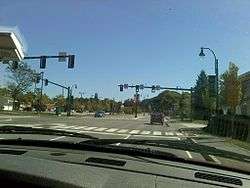
In some instances, traffic may turn left (in jurisdictions with left-hand traffic) or right (in jurisdictions with right-hand traffic) after stopping at a red light, providing they give way to the pedestrians and other vehicles. In some places that generally disallow this, a sign next to the traffic light indicates that it is allowed at a particular intersection.[61] Conversely, jurisdictions that generally allow this might forbid it at a particular intersection with a "no turn on red" sign, or put a green arrow to indicate specifically when a turn is allowed without having to yield to pedestrians (this is usually when traffic from the perpendicular street is making a turn onto one's street and thus no pedestrians are allowed in the intersection anyway). Some jurisdictions allow turning on red in the opposite direction (left in right-driving countries; right in left-driving countries) from a one-way road onto another one-way road; some of these even allow these turns from a two-way road onto a one-way road.[62] Also differing is whether a red arrow prohibits turns; some jurisdictions require a "no turn on red" sign in these cases. A study in the State of Illinois (a right-driving jurisdiction) concluded that allowing drivers to proceed straight on red after stopping, at specially posted T-intersections where the intersecting road went left only, was dangerous. Proceeding straight on red at T-intersections where the intersecting road went left only used to be legal in Mainland China, with right-hand traffic provided that such movement would not interfere with other traffic, but when the Road Traffic Safety Law of the People's Republic of China took effect on 1 May 2004, such movement was outlawed.[63] In some other countries, the permission is indicated by a flashing amber arrow (cars do not have to stop but must give way to other cars and pedestrians) in Western Europe, or by a green arrow at the same height as the full red light (whether cars have to stop depends on the country) in Central Europe.
Another distinction is between intersections that have dedicated signals for turning across the flow of opposing traffic and those that do not. Such signals are called dedicated left-turn lights in the United States and Canada (since opposing traffic is on the left). With dedicated left turn signals, a left-pointing arrow turns green when traffic may turn left without opposing traffic and pedestrian conflict, and turns red or disappears otherwise. Such a signal is referred to as a "protected" signal if it has its own red phase; a "permissive" signal does not have such a feature. Three standard versions of the permissive signal exist: One version is a horizontal bar with five lights – the green and amber arrows are located between the standard green and amber lights. A vertical five-light bar holds the arrows underneath the standard green light (in this arrangement, the amber arrow is sometimes omitted, leaving only the green arrow below the steady green light, or possibly an LED based device capable of showing both green and amber arrows within a single lamp housing). Some newer LED turn arrows seen in parts of Canada are capable of multicoloured animation. Such lights will often display a flashing and animated green or amber arrow when the dedicated turn is allowed, but then transform into a red arrow on a white background with a red line through it, emphasising that the turn is no longer allowed. These lights will also often have the words "no turn" displayed, or an explanatory reason why the turn is not allowed, such as "train" in the case of a rail or light rail crossing. A third type is known as a "doghouse" or "cluster head" – a vertical column with the two normal lights is on the right side of the signal, a vertical column with the two arrows is located on the left, and the normal red signal is in the middle above the two columns. Cluster signals in Australia and New Zealand use six signals, the sixth being a red arrow that can operate separately from the standard red light. In a fourth type, sometimes seen at intersections in Ontario and Quebec, Canada, there is no dedicated left-turn lamp per se. Instead, the normal green lamp flashes rapidly, indicating permission to go straight as well as make a left turn in front of opposing traffic, which is being held by a steady red lamp. (This "advance green," or flashing green can be somewhat startling and confusing to drivers not familiar with this system. This also can cause confusion amongst visitors to British Columbia, where a flashing green signal denotes a pedestrian controlled crosswalk. For this reason, Ontario is phasing out the use of flashing green signals and instead replacing them with arrows.)[64][65] Another interesting practice seen at least in Ontario is that cars wishing to turn left that arrived after the left turn signal ended can do so during the amber phase, as long as there is enough time to make a safe turn.[66]
A flashing amber arrow, which allows drivers to make left turns after giving way to oncoming traffic, is becoming more widespread in the United States, particularly in Oregon, North Carolina, Virginia, Michigan (replacing their trademark "red-ball" flashing left-turn lights), and Las Vegas, Nevada. In the normal sequence, a protected green left-turn arrow will first change to a steady amber arrow to indicate the end of the protected phase, then to a flashing amber arrow, which remains flashing until the standard green light changes to amber and red. These generally take the form of four signal sections (green, amber, amber arrow, red). On some newer signals, notably in the city of Bend, Oregon, the green and flashing amber arrows emanate from the same light section through the use of a dual-colour LED array, while the steady amber arrow is mounted above it. In Las Vegas, the arrow turns flashing amber from a red light, before turning red again.
Generally, a dedicated left-turn signal is illuminated at the beginning of the green phase of the green-amber-red-green cycle. This is called a leading turn. This allows left-turn traffic, which often consists of just a few cars, to vacate the intersection quickly before giving priority to vehicles traveling straight. This increases the throughput of left-turn traffic while reducing the number of drivers, perhaps frustrated by long waits in heavy traffic for opposing traffic to clear, attempting to make an illegal left turn on red. A dedicated left-turn signal that appears at the end of the green phase is called a lagging turn. If there is no left-turn signal, the law requires one to yield to oncoming traffic and turn when the intersection is clear and it is safe to do so. In the U.S., many older inner-city and rural areas do not have dedicated left-turn lights, while most newer suburban areas have them. Such lights tend to decrease the overall efficiency of the intersection as it becomes congested, although it makes intersections safer by reducing the risk of head-on collisions and may even speed up through traffic, but if a significant amount of traffic is turning, a dedicated turn signal helps eliminate congestion.
Some intersections with permissive turn signals occasionally have what is known as "yellow trap", "lag-trap", or "left turn trap" (in right-driving countries). This refers to situations when left-turning drivers are trapped in the intersection with a red light, while opposing traffic still has a green. In British Columbia, the law addresses this problem by giving a left-turning driver already in an intersection the right-of-way to make the turn once the intersection is otherwise clear, regardless of the traffic light state.
For example, an intersection has dedicated left-turn signals for traffic traveling north. The southbound traffic gets a red light so northbound traffic can make a left turn, but the straight-through northbound traffic continues to get a green light. A southbound driver who had entered the intersection earlier will now be in a predicament, since they have no idea whether traffic continuing straight for both directions is becoming red, or just their direction. The driver will now have to check the traffic light behind them, which is often impossible from the viewing angle of a driver's seat. This can also happen when emergency vehicles or railroads preempt normal signal operation. [67] In the United States, signs reading "Oncoming traffic has extended green" or "Oncoming traffic may have extended green" must be posted at intersections where the "yellow trap" condition exists.[68][69]
Although motorcycles and scooters in most jurisdictions follow the same traffic signal rules for left turns as do cars and trucks, some places, such as Taiwan, have different rules. In these areas, it is not permitted for such small and often hard-to-see vehicles to turn left in front of oncoming traffic on certain high-volume roads when there is no dedicated left-turn signal. Instead, in order to make a left turn, the rider moves to the right side of the road, travels through the first half of the intersection on green, then slows down and stops directly in front of the line of cars on the driver's right waiting to travel across the intersection, which are of course being held by a red light. There is often a white box painted on the road in this location to indicate where the riders should group. The rider turns the bike 90 degrees to the left from the original direction of travel and proceeds along with the line of cars when the red light turns green, completing the left turn. This procedure improves safety because the rider never has to cross oncoming traffic, which is particularly important given the much greater likelihood of injury when a cycle is hit by a car or truck. This system (called a "hook turn") is also used at many intersections in the central business district (CBD) of Melbourne, Australia, where either or both streets carry tramways. This is done so right-turning vehicles (Australia drives on the left) do not block the passage of trams. The system is being extended to the suburbs.
Lane control
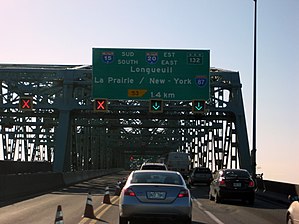
Lane-control lights are a specific type of traffic light used to manage traffic on a multi-way road, highway or tollway. Typically, these lights allow or forbid traffic to use one or more of the available lanes by the use of green lights or arrows (to permit) or by red lights or crosses (to prohibit). In the US, lane-control lights are often used to control and/or direct the flow of traffic through toll plazas and highway tunnels, such as during unusually-heavy traffic flow when more lanes may be required in one direction than in the other direction, or during a hurricane evacuation, when the lane signals for most or all lanes will show green for one direction to assist in more rapid traffic flow from the evacuation site. Lane-control lights are also used at highway weigh stations to direct tractor-trailers and other heavy or oversized vehicles into the proper lanes for weighing, inspection or exit.
In the US, most notably the Southeastern, there often is a "continuous-flow" lane. This lane is protected by a single, constant-green arrow pointing down at the lane(s) permitting the continuous flow of traffic, without regard to the condition of signals for other lanes or cross streets. Continuous lanes are restricted in that vehicles turning from a side street may not cross over the double white line to enter the continuous lane, and no lane changes are permitted to the continuous lane from an adjacent lane or from the continuous lane to an adjacent lane, until the double white line has been passed. Some continuous lanes are protected by a raised curb located between the continuous lane and a normal traffic lane, with white and/or amber reflective paint or tape, prohibiting turning or adjacent traffic from entering the lane. Continuous-flow traffic lanes are found only at "T" intersections where there is no side street or driveway entrance on the right side of the main thoroughfare; additionally, no pedestrians are permitted to cross the main thoroughfare at intersections with a continuous-flow lane, although crossing at the side street may be permitted. Intersections with continuous-flow lanes will be posted with a white regulatory sign approximately 500 ft (150 m) before the intersection with the phrase, "right lane continuous traffic," or other, similar, wording. If the arrow is extinguished for any reason, whether by malfunction or design, traffic through the continuous lane will revert to the normal traffic pattern for adjacent lanes, except that turning or moving into or out of the restricted lane is still prohibited.
Speed sign
A speed sign is a special traffic light, variable traffic sign or variable-message sign giving drivers a recommended speed to approach the next traffic light in its green phase[70] and avoid a stop due reaching the intersection when lights are red.[71][note 2]
Special provisions
Traffic light failure in most jurisdictions in Australia and countries in Europe must be handled by drivers as a priority-to-the-right intersection, or an all-way stop elsewhere, pending the arrival of a police officer to direct traffic. In Armenia, Belarus, Belgium, Bosnia and Herzegovina, Croatia, Czech Republic, Estonia, France, Georgia, Germany, Greece, Iceland, Italy, Kazakhstan, Kosovo, Latvia, Lithuania, Luxembourg, Moldova, Netherlands, Poland, Portugal, Romania, Russia, Serbia, Slovakia, Slovenia, Sweden, Switzerland (and Liechtenstein), Turkey, and Ukraine,[72][73][74][75][76][77][78][79][80][81][82][83][84][85][86][87][88][89][90][91][92][93][94][95][96][97][98][99][100][101][102] traffic lights may have additional right-of-way signs mounted above, below or next to the traffic lights; these take effect when the lights are no longer active or are flashing amber. A flashing amber traffic light usually indicates you have a yield or stop sign as a redundant sign, while a turned off traffic light usually indicates you have the right-of-way. In the UK and parts of North America, drivers simply treat the junction as being uncontrolled when traffic lights fail, giving way as appropriate, unless a police officer is present. In much of the United States failed traffic signals must be treated as all-way stop intersections.
In the US, traffic lights inactive at nighttime emit an amber-coloured flashing signal in directions owing priority while the intersecting street emit a flashing red light, requiring drivers to stop before proceeding.
Dummy lights
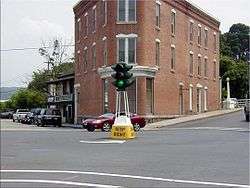
In an era when intersections were often controlled by a single traffic signal head, many signals were installed on pedestals in the centers of intersections. Often referred to as "dummy lights," these installations often replaced beacons or "mushrooms" that denoted the centers of intersections and separated opposing traffic, with the infrastructure used for the beacons and mushrooms serving the new "stop and go" type signals.
There are a handful of operational dummy lights still in service. Three are located in New York State: Beacon, Canajoharie and Croton-on-Hudson.[103]
After a dummy light was knocked down by a truck in 2010, the city of Coleman, Texas decided to preserve and refurbish its last two pedestal mounted dummy lights as part of its historic district preservation efforts.
In 2011, the Arkansas State Historic Preservation Office nominated the state's last remaining pedestal mounted signal, located in Smackover, to be listed on the National Register of Historic Places.
The oldest working 'dummy' style beacon in Rhode Island was located in the Historic Mill village of Albion in the Blackstone River Valley (town of Lincoln, RI). It was erected in 1932 above where the old village well stood in the center square. In April 2015 it was destroyed by a motorist. The beacon was a local historical site and the logo for a local Boy Scout Troop, Troop 711 Albion.
Increases in traffic flows have prompted calls for these types of traffic lights to be removed due to safety concerns, but their historic value has kept these landmarks at their original locations. To serve historic district applications, Teeco Safety Systems of Shreveport, Louisiana, still manufactures replacement fixed 4-way traffic signals for pedestal and overhead span wire installations.[104]
Technology
Optics and lighting
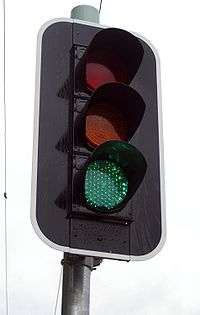
Traditionally, incandescent and halogen bulbs were used. Because of the low efficiency of light output and a single point of failure (filament burnout) municipalities are retrofitting traffic signals with LED arrays that consume less power, have increased light output, last significantly longer. Moreover, in the event of an individual LED failure, the aspect will still operate albeit with a reduced light output. The light pattern of an LED array can be comparable to the pattern of an incandescent or halogen bulb fitted with a prismatic lens.
The low energy consumption of LED lights can pose a driving risk in some areas during winter. Unlike incandescent and halogen bulbs, which generally get hot enough to melt away any snow that may settle on individual lights, LED displays – using only a fraction of the energy – remain too cool for this to happen.[105][106] As a response to the safety concerns, a heating element on the lens was developed.[107][108]
Programmable visibility signals
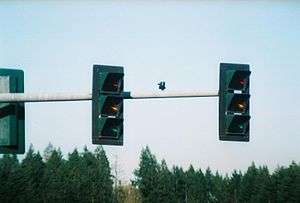
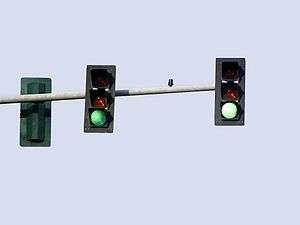
Signals such as the 3M High Visibility Signal and McCain Programmable Visibility signal utilize light-diffusing optics and a Fresnel lens to create the signal indication. The light from a 150 W PAR46 sealed-beam lamp in these "programmable visibility" signals passes through a set of two glass lenses at the back of the signal. The first lens, a frosted glass diffusing lens, diffuses the light into a uniform ball of light around five inches in diameter. The light then passes through a nearly identical lens known as an optical limiter (3M's definition of the lens itself), also known as a "programming lens", also five inches in diameter.
Using a special aluminum foil-based adhesive tape, these signals are "masked" or programmed by the programming lens so that only certain lanes of traffic will view the indication. At the front of these programmable visibility signals is a 12" Fresnel lens, each lens tinted to meet United States Institute of Transportation Engineers (ITE) chromaticity and luminance standards. The Fresnel lens collimates the light output created by the lamp, and creates a uniform display of light for the lane in which it is intended. These signals were first developed by the 3M Company in the late 1960s, and were popular in the late 1970s as traffic density increased.
In addition to being positioned and mounted for desired visibility for their respective traffic, some traffic lights are also aimed, louvered, or shaded to minimize misinterpretation from other lanes. For example, a Fresnel lens on an adjacent through-lane signal may be aimed to prevent left-turning traffic from anticipating its own green arrow.
Today, McCain Traffic Systems is the only U.S.-based manufacturer producing optically programmable traffic signals similar to the 3M model. Intelight Inc. manufactures a programmable traffic signal that uses a software-controlled LED array and electronics to steer the light beam toward the desired approach.[109] The signal is programmed unlike the 3M and McCain models. It requires a connection to a laptop or smartphone with the manufacturer software installed. Connections can be made directly with a direct-serial interface kit, or wirelessly with a radio kit over WIFI to the signal.
In addition to aiming, Fresnel lenses, and louvers, visors and back panels are also useful in areas where sunlight would diminish the contrast and visibility of a signal face.
Typical applications for these signals were skewed intersections, specific multi-lane control, left-turn pocket signals or other areas where complex traffic situations existed.
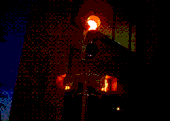
Conventional lighting systems
Conventional traffic signal lighting, still common in some areas, utilizes a standard light bulb. Typically, a 67, 69, or 115 watt medium-base (household lamp in the US) light bulb provides the illumination. Light then bounces off a mirrored glass or polished aluminium reflector bowl, and out through a polycarbonate plastic or glass signal lens. In some signals, these lenses were cut to include a specific refracting pattern. Crouse-Hinds is one notable company for this practice. In the 1930s throughout the 1950s, they utilized a beaded prismatic lens with a "smiley" pattern embossed into the bottom of each lens.
Light design
In the United States, traffic lights are currently designed with lights approximately 12 inches (300 mm) in diameter. Previously the standard had been 8 inches (200 mm); however, those are slowly being phased out in favor of the larger and more visible 12 inch lights. Variations used have also included a hybrid design, which had one or more 12 inch lights along with one or more lights of 8 inches (200 mm) on the same light. For example, these "12-8-8" (along with 8-8-8) lights are standard in most jurisdictions in Ontario, Manitoba, and British Columbia (that, is, the red light is 12 and others 8, making the red more prominent).
In the United Kingdom, 12 inch lights were implemented only with Mellor Design Signal heads designed by David Mellor. These were designed for symbolic optics to compensate for the light loss caused by the symbol. However, following a study sponsored by the UK Highways Agency and completed by Aston University, Birmingham, UK, an enhanced optical design was introduced in the mid 1990s. Criticism of sunlight washout (cannot see the illuminated signal due to sunlight falling on it), and sun-phantom (signal appearing to be illuminated even when not due to sunlight reflecting from the parabolic mirror at low sun angles), led to the design of a signal that used lenslets to focus light from a traditional incandescent bulb through apertures in a matt black front mask. This cured both problems in an easily manufactured solution. This design proved very successful and was taken into production by a number of traffic signal manufacturers through the engineering designs of Dr Mark Aston, working firstly at the SIRA Ltd in Kent, and latterly as an independent optical designer. The manufacturers took a licence for the generic design from the Highways Agency, with Dr Aston engineering a unique solution for each manufacturer. Producing both bulb and LED versions of the signal aspects, these signals are still the most common type of traffic light on UK roads. With the invention of anti-phantom, highly visible Aston lenses, lights of 8 inches (200 mm) could be designed to give the same output as plain lenses, so a larger surface area was unnecessary. Consequently, lights of 12 inches (300 mm) are no longer approved for use in the UK and all lights installed on new installations have to be 200 mm (8 in) in accordance with TSRGD (Traffic Signs Regulations and General Directions). Exemptions are made for temporary or replacement signals.
Technological advancements
With technologies in developed countries continuing to advance, there is now an increasing move to develop and implement smart traffic lights on the roads. These are systems that adapt to information that is received from a central computer about the position, speed and direction of vehicles. They try to communicate with cars to alert drivers of impending light changes and reduce motorists' waiting time considerably. Trials are currently being conducted for the implementation of these advanced traffic lights but there are still many hurdles to widespread use that need to be addressed; one of which is the fact that few cars yet have the required systems to communicate with these light
Control and coordination
Mounting
There are significant differences from place to place in how traffic lights are mounted or positioned so that they are visible to drivers. Depending upon the location, traffic lights may be mounted on poles situated on street corners, hung from horizontal poles or wires strung over the roadway, or installed within large horizontal gantries that extend out from the corner and over the right-of-way. In the last case, such poles or gantries often have a lit sign with the name of the cross-street.
- Mounted traffic lights in North America
- An example of a wire-mounted traffic light in Fort Worth, Texas.
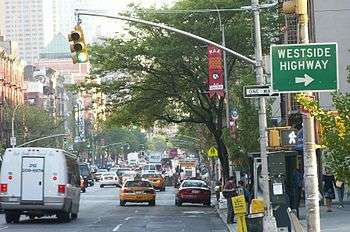 A typical traffic light on Ninth Avenue in New York City. Note that the traffic light gantry is of a guy-wire masted style, which is unique to New York City.
A typical traffic light on Ninth Avenue in New York City. Note that the traffic light gantry is of a guy-wire masted style, which is unique to New York City.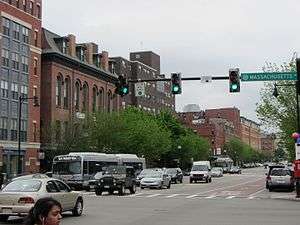 A vertically mounted traffic light in Boston.
A vertically mounted traffic light in Boston.- Example of horizontally mounted traffic light in Trenton, New Jersey.
- Horizontally mounted traffic lights in Calgary, Alberta.
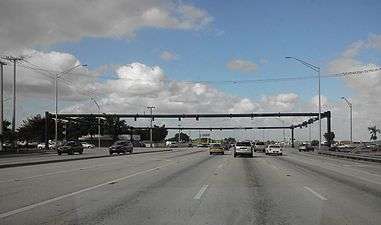 A bulky tubular metal structure. Not only is the intersection very large, but due to its location on Florida's east coast, the traffic lights must be hurricane resistant.
A bulky tubular metal structure. Not only is the intersection very large, but due to its location on Florida's east coast, the traffic lights must be hurricane resistant.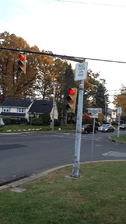 Angled mast-arms, which were frequently used in the state of Pennsylvania during the 1960s and 1970s.
Angled mast-arms, which were frequently used in the state of Pennsylvania during the 1960s and 1970s.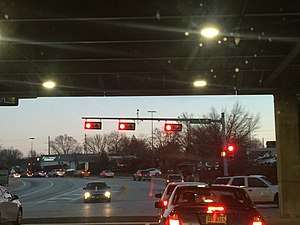 Three horizontally mounted traffic lights for visibility under a bridge in King of Prussia, Pennsylvania. Pennsylvania typically mounts traffic lights vertically.
Three horizontally mounted traffic lights for visibility under a bridge in King of Prussia, Pennsylvania. Pennsylvania typically mounts traffic lights vertically.
In some locations, lights are mounted with their multiple faces arranged horizontally, often with supplemental vertical signals on the side, while others locations use vertical signals almost exclusively. Horizontal signals have consistent orientation, like their vertical counterparts.[110] Often, supplemental curb pedestal mounts, intended to support a signal for a different approach road, are used when primary signals are partially obscured due to structures such as overpasses, approaches around a building that obscure the primary signal mountings, and unusual approach geometry. In Florida, horizontal signals mounted on poles, known as "mast arms", are in wide use due to their lower wind profile, important for minimizing hurricane damage. In areas where wind-load is not as much of a concern as ice-load, such as Illinois or Minnesota, the lights are mounted vertically to reduce the accumulation of ice or snow over the surface of the signal heads. In a few countries such as Japan, South Korea, Mexico and a few jurisdictions in Canada and the US such as Texas, New Mexico, Florida, Wisconsin, Nebraska, Quebec (excluding Greater Montreal), New Brunswick, Prince Edward Island and Alberta, most traffic signals are mounted horizontally.
Traffic signals in most areas of Europe are located at the stop line on same side of the intersection as the approaching traffic (there being both right- and left-hand traffic) and are often mounted overhead as well as on side of the road. At particularly busy junctions for freight, higher lights may be mounted specifically for trucks. The stop line alignment is done to prevent vehicles blocking any crosswalk and allow for better pedestrian traffic flow. There may also be a special area a few meters in advance of the stop line where cyclists may legally wait but not motor vehicles; this advanced stop line is often painted with a different road surface with greater friction and a high colour, both for the benefit of cyclists and for other vehicles. The traffic lights are mounted so that cyclists can still see them.
In Spain, the mounted traffic lights on the far side of the intersection is meant for the traffic that exits the intersection in that particular direction. This is often done due to the pedestrian crossings, so that traffic has to wait if they get a red light. These intersections also come with a stop line in the exit area of the intersection.
In North America, there is often a pole-mounted signal on the same side of the intersection, but additional pole-mounted and overhead signals are usually mounted on the far side of the intersection for better visibility. Most traffic lights are mounted that way in the Western United States and Canada. In Ontario, traffic lights are almost always mounted on the far side of the intersection with poles.
In some areas of the United States, signals facing in up to four directions are hung directly over the intersection on a wire strung diagonally over the intersection (once common in Michigan), or the signal faces traffic in one direction, still hung by wires (but the wire is strung horizontally between two adjacent corners of the intersection). This is common in the Southern and Eastern United States.
In other countries like Australia, New Zealand, Lebanon and the United Kingdom, traffic lights are mounted at the stop line before the intersection and also after the intersection. Some busy intersections have an overhead traffic light for heavy vehicles and vehicles further away.
Effects
Traffic lights can have both positive and negative effects on traffic safety and traffic flow. The separation of conflicting streams of traffic in time can reduce the chances of right-angle collisions by turning traffic and cross traffic, but they can increase the frequency of rear-end crashes by up to 50%.[111] Since right-angled and turn-against-traffic collisions are more likely to result in injuries, this is often an acceptable trade-off. They can also adversely affect the safety of bicycle and pedestrian traffic.
Traffic lights can increase the traffic capacity at intersections and reduce delay for side road traffic, but can also result in increased delay for main road traffic.[112] Hans Monderman, the innovative Dutch traffic engineer, and pioneer of shared space schemes, was sceptical of their role, and is quoted as having said of them: "We only want traffic lights where they are useful and I haven't found anywhere where they are useful yet."[113]
Between 1979 and 1988, the city of Philadelphia, Pennsylvania, removed signals at 199 intersections that were not warranted. On average, the intersections had 24% fewer crashes after the unwarranted signals were removed.[111] The traffic lights had been erected in the 1960s because of since-resolved protests over traffic. By 1992, over 800 traffic lights had been removed at 426 intersections, and the number of crashes at these intersections dropped by 60%.[114]
Justification
Criteria have been developed to help ensure that new traffic lights are installed only where they will do more good than harm, and to justify the removal of existing traffic lights where they are not warranted. They are most often placed on arterial roads at intersections with either another arterial road or a collector road, or on an expressway where an interchange is not warranted. In some situations, traffic signals can also be found on collector roads in busy settings.
United States
In the United States, the criteria for installation of a traffic control signal are prescribed by the Manual on Uniform Traffic Control Devices (MUTCD), which defines the criteria in nine warrants:[115]
- Eight-hour vehicular volume. Traffic volume must exceed prescribed minima for eight hours of an average weekday.
- Four-hour vehicular volume. Traffic volume must exceed prescribed minima for four hours of an average weekday.
- Peak hour volume or delay. This is applied only in unusual cases, such as office parks, industrial complexes, and park and ride lots that attract or discharge large numbers of vehicles in a short time, and, for a minimum of one hour of an average weekday. The side road traffic suffers undue delays when entering or crossing the major street.
- Pedestrian volume. If the traffic volume on a major street is so heavy that pedestrians experience excessive delays in attempting to cross it.
- School crossing. If the traffic density at school crossing times exceeds one per minute which is considered to provide too few gaps in the traffic for children to safely cross the street.
- Coordinated signal system. For places where adjacent traffic control signals do not keep traffic grouped together efficiently.
- Crash experience. The volumes in the eight- and four-hour warrants may be reduced if five or more right-angle and cross traffic turn collisions have happened at the intersection in a twelve-month period.
- Roadway network. Installing a traffic control signal at some intersections might be justified to encourage concentration and organization of traffic flow on a roadway network.
- Intersection near a grade crossing. A traffic control signal is often justified at an intersection near a railroad crossing, in order to provide a preemption sequence to allow traffic queued up on the tracks an opportunity to clear the tracks before the train arrives.
An intersection is usually required to meet one or more of these warrants before a signal is installed. However, meeting one or more warrants does not require the installation of a traffic signal, it only suggests that they may be suitable. It could be that a roundabout would work better. There may be other unconsidered conditions that lead traffic engineers to conclude that a signal is undesirable. For example, it may be decided not to install a signal at an intersection if traffic stopped by it will back up and block another, more heavily trafficked intersection. Also, if a signal meets only the peak hour warrant, the advantages during that time may not outweigh the disadvantages during the rest of the day.
Legal implications
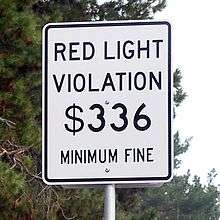
In virtually all jurisdictions in which they are used, it is an offence for motorists (and other road users) to disobey traffic control devices, such as traffic lights. Exceptionally, it is not an offence for pedestrians to cross against a red light in the United Kingdom, where pedestrian lights officially give advice, rather than an instruction, although UK pedestrians do commit an offence if they cross a road against the signals of a police officer controlling traffic.
Perhaps the most obvious common traffic-light related offence is failing to stop for a red light. In some jurisdictions, running an amber light may also incur a penalty.
In some jurisdictions (such as Toronto, Washington, D.C., New York City, and California), there are ordinances or by-laws against "gridlocking". A motorist entering an intersection (even if on a green light) but unable to proceed and who gets stranded in the intersection (when traffic ahead fails to proceed), and who remains after the light turns red (thus blocking traffic from other directions) may be cited. The definition of the intersection area is that square where the two streets overlap marked by the inner lines of each crosswalk. (Occupying the space inside the crosswalk lines is itself a traffic infraction, but different from gridlocking). This gives the meaning to the anti-gridlock slogan "don't block the box". This is sometimes used as a justification for making a turn across the opposing travel lanes on a red light at a busy intersection, by pulling partway into the intersection at a green light waiting to perform the turn, and, if oncoming traffic is not abated before the light changes to red, proceeding to turn once the light has turned red and opposing traffic has stopped. This means that at busy junctions without a protected green arrow for turning traffic, one turns after the light turns red. This maneuver is commonly referred to as "occupying the intersection" or "being legally allowed to complete one's turn". In some jurisdictions, including most American states, a vehicle already in the intersection when the light turns red legally has the right of way, and vehicles who have green must yield to the vehicle in the intersection.
In Sackville, New Brunswick, it is customary for through traffic to voluntarily yield to the first oncoming left-turning vehicle to allow it to perform a "Pittsburgh left" manoeuvre. This is similar to a hook turn performed in Melbourne, Australia, which is legal at signed intersections.
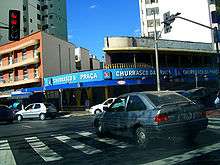
Enforcement of traffic lights is done in one of several ways:
- by police officers observing traffic, and issuing citations to motorists who violate the signal
- as a result of an accident investigation, if it is determined that one or more motorists ran the red light – even if the incident was not observed by a police officer
- with red light cameras
Red light running
Jurisdictions differ somewhat on how to deal with "red light running" — attempts by motorists to race to an intersection while facing an amber light, in an attempt to beat the red. In some locales, as long as the light is amber when the motorist enters the intersection, no offence has been committed; in others, if the light turns red at any time before a motorist clears the intersection, then an offence occurs. In New York City the amber light is very short (only about three seconds) in order to discourage driving through. In Oregon and other places, a stricter standard applies—running an amber light is an offence, unless the motorist is unable to stop safely. This standard has been criticized as ambiguous and difficult to enforce (red light cameras in Oregon are activated only if a motorist enters the intersection on a red). Red light cameras in New South Wales, Australia, are activated only if a motorist enters an intersection 0.3 seconds after the light has turned red.[116]
_f005.jpg)
In Russia, it is illegal to enter an intersection on a yellow signal, except for situations where motorists are unable to safely come to a stop. Most traffic lights on busy intersections have an additional "flashing green" phase right before the amber phase, warning motorists that the signal is about to change.[117] Some traffic signals also feature an additional aspect (positioned directly to the right of the bottommost aspect, or alternatively, in the same aspect as the amber light) with a digital countdown timer, informing approaching motorists how much time there is left before the signal switches to amber.[117]
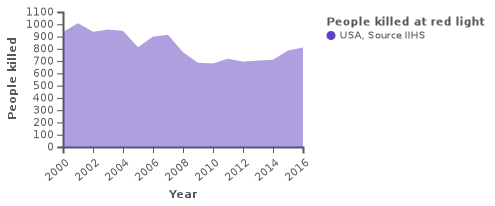
Source: IIHS[118]
As urban centers become more dense and vehicles and pedestrians come into closer contact with each other, the risk of crashes increases. With the rapid increase of vehicles for hire through smart phone apps and the competition from taxis and livery cabs, the urgency to complete as many rides in as short a period of time as possible has led to drivers pushing the limits on red lights. According to the IIHS Insurance Institute for Highway Safety, every year red light running causes hundreds of deaths, thousands of injuries and hundreds of millions of dollars in related costs.[119]
In Spring 2015, Hunter College in New York City completed an observational study of red light running, the first of its kind. The conclusion, after monitoring 3,259 vehicles at 50 intersections over a period of days around the 5 boroughs, found that almost 10% of vehicles and 15% of taxis ran the red light, amounting to nearly 400,000 red lights run every single day.[120] New York City Mayor Bill de Blasio launched a Vision Zero plan to reduce vehicular and pedestrian fatalities. The New York City Police Department's 2014 TrafficStat report showed 33,577 red light tickets for 2013, which is 126% increase in the number of failure-to-yield summonses and red-light running violations.[121]

The Amber Gambler Twins is one of many public interest films trying to change the public's behavior regarding running of amber lights.[122][123]
A 2017 survey in the USA showed that 92.9% US motorists found unacceptable running a red light, when 42.7% of them did it in the previous 30 days. 91.4% of motorists perceive breaches in the red light systems as a serious or somewhat serious personal safety concern[124] · .[125]
Red light runner involved in multiple vehicle crashes, are more likely male, younger, involved in prior crash, or have alcohol impaired driving conviction.[124]
Red light cameras
In some countries, red light cameras are used for either the driver or the vehicle's owner. An automated camera is connected to the triggering mechanism for the corresponding traffic light, which is programmed to photograph a vehicle and driver crossing against the light. Either the driver or the vehicle's owner (depending on the locale) are fined for the violation. In some jurisdictions, including the United States and Italy, private companies have been contracted to operate traffic-related cameras and receive a portion of the resulting revenues. In some cases red light cameras have been abused by local governments, where vehicle operators have been fined as a result of traffic systems that have been improperly modified.[126][127] Despite the fact that cameras can reduce the number of crashes, it has been proven that at these intersections drivers tended to react quicker to an amber light change when stopping.[128][129] The consequence of this change could be the slight decline in the intersection capacity.
Confirmation lights
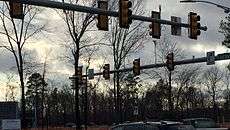
Another way police officers have begun to combat red light runners is with blue or white Confirmation Lights.[130] These lights can be seen from any angle in an intersection and are typically utilised by emergency responders who actuate traffic signal preemption devices to verify that other motorists are facing a red signal. However, confirmation lights also assist officers – who do not have to have a line-of-sight with a red light – to catch vehicles illegally entering an intersection. They are only lit when the red light on the same signal head is on. Some intersections will also have multiple confirmation lights for a single direction of travel if there are different signals for different directions. These lights are separate from the main ones, often protrude above or below the main traffic light, and are much smaller than a standard light to help avoid confusion.
In the Netherlands, many traffic signals that are red can be seen from the side via a small bulbous window, indicating to drivers (and police officers) whether the signal in the crossing direction is actually red or not, by simply leaking out some of the red light through the side of the traffic signal. This has gradually become less common as traditional incandescent signals are replaced by LED signals, while increasingly red light cameras are used to detect driving-through-red violations.
Light timing length
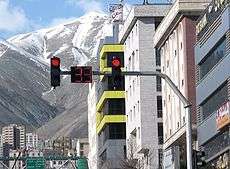
The length of amber lights can differ, for example in many places the length of an amber light is usually four or five seconds, but elsewhere it may be as little as three, considerably reducing the time for reaction. It is typical for these times to vary according to the set speed limit, with longer times for higher limits. In the U.S. state of Georgia, an amber light must be lit one second for every 10 miles per hour (16 km/h) of posted speed limit. For intersections with red light cameras, one extra second must be added. In Colorado Springs, Colorado, amber lights at numerous intersections have been noted with durations of approximately two seconds. In the United States, there is a recommended federal safety minimum of three seconds for amber lights.[131]
The time from when a red light is displayed and when a cross street is given a green light is usually based on the physical size of the intersection. This intervening period is called the "all-red time". A typical all-red time is two seconds to allow cars to clear the intersection. In a wider intersection, such as a four-lane road or highway intersection, the all-red time may be as much as five seconds, allowing drivers who could not or would not stop at the amber light enough time to clear the intersection without causing a collision. Two exceptions are in New Westminster, British Columbia, Canada, and Winnipeg, Manitoba, Canada, where there is no all-red time. The change is instantaneous, due to the nature of the older relay operated signals. It is also the case in Montreal, Quebec, Canada.
Turn on red
Some jurisdictions allow right turns when a steady red light is shown.
Non-detected vehicles
In some instances, small vehicles such as motorcycles, scooters, and bicycles may not be detected, leaving the traffic light controller unaware of their presence. When this occurs, the small vehicle may fail to receive the right of way when the traffic light controller skips their phase, such as at traffic lights that are programmed to remain green for the main street and to only service minor movements, such as the side street or a main street left turn lane, on an as-needed basis when there is demand.
For example, small vehicles may not be detected by an induction loop sensor, such as one whose sensitivity has been set too high in an attempt to avoid false triggers. While a typical motor vehicle has a sufficient mass of metal such as steel that interacts with the sensor's magnetic field,[132] motorcycles and scooters have much less mass than cars, and bicycles may not even be constructed with metal. This situation most often occurs at the times of day when other traffic is sparse as well as when the small vehicle is coming from a direction that does not have a high volume of traffic.[133]
United States
Traffic lights that do not service traffic due to non-detection may not meet the federal legal definition adopted by most states for a traffic control signal, which is any device "by which traffic is alternately directed to stop and permitted to proceed".[134][135][136] Meeting this definition is required for any citation to be upheld; traffic signals that fail to meet it may be considered "defective" or "inoperative."[137]
Some jurisdictions require operators to "bring the vehicle to a complete stop before entering the intersection and may proceed with caution only when it is safe to do so,"[138] while others may construe any action to force it to cycle as tampering.[139]
Over 20 states[140][141] in the United States have enacted "dead red" laws that give motorcyclists and sometimes bicyclists an affirmative defense to proceed through a red light with caution after stopping when they are not detected by the traffic light controller.[142][143]
- Arkansas 27-52-206
- California 21800 (d)(1)
- Colorado 42-4-612
- Idaho 49-802 (3)(a)
- Illinois 11-306 (c)(3.5)
- Indiana 9-21-3-7 (b)(3)(D)
- Kansas 8-1508 (c)(4)
- Kentucky 189-338 (6)
- Minnesota 169.06 Subd. 9
- Missouri 304.285
- Nevada 484B.307 (8)(d)
- North Carolina 20-158 (e)
- Ohio 4511.132 (A)
- Oklahoma 47-11-202 (3)(d)[144]
- Oregon 811.360 (2)(a)
- Pennsylvania 75-3112 (c)(2)[145]
- South Carolina 56-5-970 (5)
- Tennessee 55-8-110 (b)
- Utah 41.6a.305 (7)
- Virginia 46.2-833 (B)
- Washington 46.61.184
- Wisconsin 346.37 (1)(c)(4)
- Pending Legislation: Massachusetts MA H.3182
- Failed: Alabama HB103, Nebraska LB 85, Wyoming HB0092
In other contexts
The symbolism of a traffic light (and the meanings of the three primary colours used in traffic lights) are frequently found in many other contexts. Since they are often used as single spots of colour without the context of vertical position, they are typically not comprehensible to up to one in ten males who are colour blind.
Traffic lights have also been used in computer software, such as the macOS user interface, and in pieces of artwork, particularly the Traffic Light tree in London, UK.
Racing
Automobile racing circuits can also use standard traffic signals to indicate to racing car drivers the status of racing. On an oval track, four sets may be used, two facing a straight-away and two facing the middle of the 180-degree turn between straight-away. Green would indicate racing is under way, while amber would indicate to slow or while following a pace car; red would indicate to stop, probably for emergency reasons.
Scuderia Ferrari, a Formula One racing team, formerly used a traffic light system during their pit stops to signal to their drivers to when to leave the pits. The red light was on when the tires were being changed and fuel was being added, amber was on when the tires were changed, and green was on when all work was completed. The system is (usually) completely automatic. However, the system was withdrawn after the 2008 Singapore Grand Prix, due to the fact that it heavily delayed Felipe Massa during the race, when he was in the lead. Usually, the system was automatic, but heavy traffic in the pit lane forced the team to operate it manually. A mechanic accidentally pressed the green light button when the fuel hose was still attached to the car, causing Massa to drive off, towing the fuel hose along. Additionally, Massa drove into the path of Adrian Sutil, earning him a penalty. He finally stopped at the end of the pit lane, forcing Ferrari's mechanics to sprint down the whole of the pit lane to remove the hose. As a result of this, and the penalty he also incurred, Massa finished 13th. Ferrari decided to use a traditional "lollipop" for the remainder of the 2008 season.
Another type of traffic light that is used in racing is the Christmas Tree, which is used in drag racing. The Christmas Tree has six lights: a blue staging light, three amber lights, a green light and a red light. The blue staging light is divided into two parts: Pre-stage and stage. Sometimes, there are two sets of bulbs on top of each other to represent them. Once a driver is staged at the starting line, then the starter will activate the light to commence racing, which can be done in two ways. If a Pro tree is used, then the three amber lights will flash at the same time. For the Sportsman tree, the amber light will flash from top to bottom. When the green light comes up, the race officially begins but if a driver crosses the line before that happens, then a red light will come up and that will be a foul.
As a rating mechanism
The colours red, amber and green are often used as a simple-to-understand rating system for products and processes. It may be extended by analogy to provide a greater range of intermediate colours, with red and green at the extremes.[146]
Gallery
 LED traffic light (using cap visors)
LED traffic light (using cap visors) Temporary LED traffic lights with sensor in Australia
Temporary LED traffic lights with sensor in Australia- Temporary traffic light in the United Kingdom
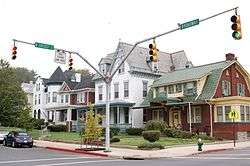 Traffic light in a small intersection in Hagerstown, Maryland (using tunnel visors)
Traffic light in a small intersection in Hagerstown, Maryland (using tunnel visors)- Example of traffic signals mounted on gantries in downtown Cincinnati, Ohio, and integrated with street signage
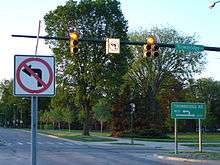 Typical set of traffic lights in East Lansing, Michigan
Typical set of traffic lights in East Lansing, Michigan Typical example of traffic lights mounted on a wide street in California
Typical example of traffic lights mounted on a wide street in California One example of traffic lights on a suburban street in Santa Clarita, California
One example of traffic lights on a suburban street in Santa Clarita, California LED traffic lights in Örnsköldsvik, Sweden
LED traffic lights in Örnsköldsvik, Sweden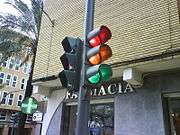 Typical set of traffic lights in Spain
Typical set of traffic lights in Spain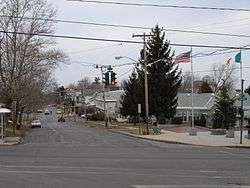 The green on top light in Tipperary Hill, Syracuse, New York
The green on top light in Tipperary Hill, Syracuse, New York LED pedestrian signal in New York City
LED pedestrian signal in New York City Traffic light in Ashgabat, Turkmenistan
Traffic light in Ashgabat, Turkmenistan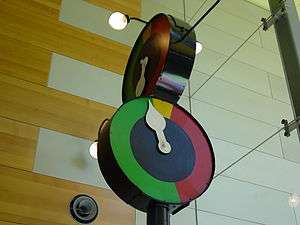 A Marshalite traffic signal, as formerly installed at various intersections in Melbourne, Australia, indicating how much time remained before a signal change.
A Marshalite traffic signal, as formerly installed at various intersections in Melbourne, Australia, indicating how much time remained before a signal change. East Rembo Buting Intersection Traffic light near Kalayaan Ave.
East Rembo Buting Intersection Traffic light near Kalayaan Ave.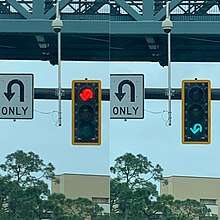 A U-turn traffic light in Lake Buena Vista, Florida.
A U-turn traffic light in Lake Buena Vista, Florida.
In Unicode
In Unicode, the symbol for U+1F6A5 🚥 HORIZONTAL TRAFFIC LIGHT and U+1F6A6 🚦 VERTICAL TRAFFIC LIGHT.
See also
Notes
- These are typically older signals. There are many examples in Houston, Texas, of this. Suspended lights constructed so that a single source simultaneously illuminates all four directions always have this characteristic: Red (in two directions) and green (in the two cross directions) with Red-amber-Green sequence on two sides and Green-amber-Red sequence on the cross sides
- Not completely correct: a variable speed sign is not solely used for the purpose of slowing the speed of motorists approaching an intersection. They are also used on freeways where the maximum safe speed is dependant on the conditions of the roadway (i.e. weather, falling rocks, risk of wildlife, etc.), such as in British Columbia, Canada.
References
- McShane, Clay (March 1999). "The Origins and Globalization of Traffic Control Signals" (PDF). Journal of Urban History. 25 (3): 379–404. doi:10.1177/009614429902500304. Retrieved 27 October 2019.
- "The man who gave us traffic lights". BBC. 22 July 2009. Retrieved 8 November 2009.
- "Traffic lights in use before there were motorcars". didyouknow.org. Retrieved 25 May 2016.
- "Traffic Lights in the UK - Meanings,Sequence & Rules for Learner Drivers". Theory Test. 28 March 2019.
- "UK Traffic Lights 57000 Tonnes Of CO2 | REUK.co.uk".
- "200mm traffic signals lighting | Competitive Traffic Signal Directly from Manufacturer | ITS Product Provider". www.trafficsolution.cn.
- "Traffic Lights Sequence". drivingtesttips.biz.
- "driving in America". What is USA News. 10 March 2014. Archived from the original on 21 February 2014. Retrieved 16 September 2013.
- Sessions, Gordon M. (1971). Traffic devices: historical aspects thereof. Washington: Institute of Traffic Engineers. p. 3. OCLC 278619.CS1 maint: ref=harv (link)
- City of Westminster blue plaque on the site
- Thames Leisure. "12 Amazing Facts About London". Archived from the original on 7 January 2017. Retrieved 25 January 2017.
- BBC. "The man who gave us traffic lights". Retrieved 27 September 2016.
- Pollard, Justin (2008). "The Eccentric Engineer: The History of Traffic Lights Is Full of Twists and Turns". Engineering and Technology. 3 (15): 93. doi:10.1049/et:20081518.
- University of London. "Westminster Road Semaphore". Victoria County History. Retrieved 3 February 2013.
- "Westminster Street Semaphore Signals.-Gas." Times [London, England] 6 January 1869: 10. The Times Digital Archive. Web. 5 August 2015. Describes the explosion but does not mention the fate of the policeman.
- "The man who gave us traffic lights". BBC. 22 July 2009. Retrieved 8 November 2009.
- Sessions (1971), p. 22.
- Sessions (1971), p. 23.
- McShane, C. (1999). "The Origins and Globalization of Traffic Control Signals". Journal of Urban History. 25 (3): 379–404 at p. 382. doi:10.1177/009614429902500304.CS1 maint: ref=harv (link)
- Sessions (1971), p. 33.
- Bellis, Mary (5 February 1952). "The History of Roads and Asphalt". Inventors.about.com. Missing or empty
|url=(help) - Sessions (1971), pp. 27–28.
- "New Traffic Signal Installed". The Motorist. Ken Pub. Co: 28–29. August 1914.
- "USPTO # 1251666 Sept. 22, 1913". Patimg2.uspto.gov. Retrieved 19 May 2009.
- Moyer, Sheldon (March 1947). "Mr. 'Trafficlight'". Motor News. Automobile Club of Michigan: 14–15, 27.
- Neato Stuff At the Ashville Museum. Ashville Area Heritage Society. Retrieved 16 April 2008.
- World's Oldest Traffic Light. RoadsideAmerica.com. Retrieved 11 February 2014.
- Castleman, Monte (29 October 2014). "Traffic Signal Trivia".
- Sessions (1971), p. 35.
- CityDig: Should I Stop or Should I Go? Early Traffic Signals in Los Angeles. Los Angeles Magazine. Retrieved 1 January 2015.
- Sessions (1971), p. 32.
- Section 1.5: "System Evolution", Traffic Control Systems Handbook, Federal Highway Administration Report FHWA-HOP-06-006, October 2005.
- McShane (1999), p. 385.
- "Garrett Morgan, inventor of one of the first traffic lights | African American Registry". www.aaregistry.org. Archived from the original on 1 March 2016. Retrieved 19 February 2016.
- A, Morgan Garrett (20 November 1923), Traffic signal, retrieved 19 February 2016
- "Traffic Controls". Exploring 20th Century London. The Museum of London. Retrieved 24 June 2013.
- "Traffic Control and Traffic Signals". Wolverhampton City Council. Archived from the original on 20 September 2008. Retrieved 1 July 2008.
- McShane (1999), p. 383.
- McShane (1999), p. 382.
- Bharadwaj, K. V. Aditya (6 August 2015). "That good old red light 50 years ago". The Hindu. Retrieved 26 August 2016.
- Sessions (1971), p. 135.
- Sessions (1971), p. 141.
- Sessions (1971), p. 143.
- "Section 4L.02 Intersection Control Beacon". Manual on Uniform Traffic Control Devices. Federal Highway Administration. 2009.
- "Traffic Signals". Carrollton Texas. Archived from the original on 13 January 2010. Retrieved 12 July 2014.
- Backhaus, Peter (25 February 2013). "The Japanese traffic light blues: Stop on red, go on what". The Japan Times. Retrieved 14 July 2017.
- "The Traffic Signs Regulations and General Directions 2016". legislation.gov.uk. The National Archives. 2016. Retrieved 14 July 2017.
- "Auckland pedestrians begin 'Barnes Dance' - NZHistory, New Zealand history online". nzhistory.net.nz. Retrieved 13 May 2020.
- Maoate-Cox, Daniela (11 September 2014). "Kate Sheppard lights encourage voting". Radio New Zealand. Retrieved 20 September 2016.
- Nicoll, Jared (8 August 2016). "Carmen Rupe lighting up Wellington streets once again". Stuff.co.nz. Retrieved 20 September 2016.
- "Traffic Signals Online - European Signals in the Collection". Archived from the original on 5 January 2010.
- Melican, Brian (28 January 2014). "Why the green man is king in Germany".
- "The Traffic Signs Regulations and General Directions 2016". www.legislation.gov.uk.
- Types of Pedestrian Crossing in the UK. 2pass.co.uk.
- "Publication on traffic lights the from the Swedish Transport Administration" (PDF).
- (in Dutch) RVV 1990 artikel 70 Official regulation of traffic rules and traffic signs
- "Emergency vehicle traffic signal preemption system". United States Patent and Trademark Office. Retrieved 7 October 2005.
- "FHWA - MUTCD - 2003 Edition Revision 1 Chapter 4F". dot.gov.
- "Emergency Vehicles at Red Signal or Stop Sign". Ohio Laws and Rules. Retrieved 22 July 2014.
- "Emergency Service and Vehicles". Virginia General Assembly. Retrieved 22 July 2014.
- nsw.gov.au Archived 6 September 2010 at the Wayback Machine. Rta.nsw.gov.au.
- Justia.com Archived 9 July 2012 at Archive.today para 3a.
- "Traffic Light Signals and Red Light Cameras". Geocities.com. Archived from the original on 24 October 2009. Retrieved 19 May 2009.
- "RoadSense for Drivers – Signs, Signals and Road Markings" (PDF). Archived from the original (PDF) on 22 October 2013. Accessed: 25 March 2014
- Ontario Traffic Manual Book 12: Traffic Signals. Ministry of Transportation of Ontario. 2012. p. 55.
- www.ontario.ca https://www.ontario.ca/document/official-mto-drivers-handbook/traffic-lights#section-5. Retrieved 3 July 2020. Missing or empty
|title=(help) - "LThe Flashing Yellow Arrow and the Yellow Trap". 7 January 2015. Retrieved 3 April 2019.
- "FHWA – MUTCD – 2003 Edition Revision 1 Chapter 4D". Mutcd.fhwa.dot.gov. Retrieved 19 May 2009.
- "FHWA – MUTCD – 2003 Edition Revision 1 Chapter 2C". Mutcd.fhwa.dot.gov. Retrieved 19 May 2009.
- Forschungsgesellschaft für Straßen- und Verkehrswesen (2000). Begriffsbestimmungen, Teil: Verkehrsplanung, Straßenentwurf und Straßenbetrieb. FGSV Verlag. p. 81.
- Andreas Richter (2005). Geschwindigkeitsvorgabe an Lichtsignalanlagen. DUV. pp. 33–34. ISBN 3-8244-0828-7.
- "Traffic lights with new features". A1Plus. Retrieved 28 April 2019.
- "Belarus - automotive aftermarket news - data - information - wolk after sales experts - Automotive Aftermarket Consulting". www.wolk-aftersales.com. Retrieved 28 April 2019.
- Limited, Alamy. "Stock Photo - Road signs in Belgium". Alamy. Retrieved 28 April 2019.
- "Bosnia. Mostar. War. Destruction. Traffic light. | Didier Ruef | Photography". didierruef.photoshelter.com. Retrieved 28 April 2019.
- "Zagreb Juggler Juggles for his Supper". Croatia Week. Retrieved 28 April 2019.
- Inc, Depositphotos, PRAGUE, CZECH REPUBLIC - AUGUST 2014: 4K montage (compilation) - road with cars - intersection (junction) - traffic lights, retrieved 28 April 2019
- "The struggle to get an apartment as a non-white single guy in Estonia". Estonian World. 15 August 2018. Retrieved 28 April 2019.
- Vogel, Mark (6 July 2008), Traffic Light in Strasbourg France with Bike light, retrieved 28 April 2019
- Law of Georgia on Traffic. 2013. p. 23.
- "germany - How to read the traffic light at this German intersection?". Bicycles Stack Exchange. Retrieved 28 April 2019.
- Limited, Alamy. "Stock Photo - Traffic lights with snow in Athens, Greece". Alamy. Retrieved 28 April 2019.
- "Traffic lights in Iceland spreading the love". www.kontraband.com. Retrieved 28 April 2019.
- Limited, Alamy. "Stock Photo - Traffic lights Rome Italy Europe". Alamy. Retrieved 28 April 2019.
- Photography, Eric Lafforgue (21 September 2010), Traffic Light in the Steppe, Astana, Kazakhstan, retrieved 28 April 2019
- "Balkanethnoexp. Part V. Kosovo". www.tema.ru. Retrieved 28 April 2019.
- dsanto (24 February 2015), Ventspilis (Ventspils, Latvia). Traffic lights - always red, just arrows go green temporary, retrieved 28 April 2019
- "in Lithuania there are plenty of spots where you are - #128570146 added by shenro at Top Gear Comp". funnyjunk.com. Retrieved 28 April 2019.
- GilPe (6 July 2014), Lëtzebuergesch: Verkéiersluucht Lëtzebuerg - 3-fach: rout-Bus fräi-gréngFrançais : Signal coloré lumineux Luxembourg - triple: rouge-bus autorisé-vertDeutsch: Lichtsignalanlage Luxemburg - 3-fach: rot-Bus frei-grün, retrieved 28 April 2019
- "Moldovan Street Signs". davidsmartin.net. Retrieved 28 April 2019.
- Limited, Alamy. "Stock Photo - Dutch Road Signs Traffic Light Yield Leiden Holland Netherlands Europe". Alamy. Retrieved 28 April 2019.
- "Road signs. Traffic light. Close up. Road infrastructure. Crosswalk Urban landscape. Warsaw, Poland – February 14, 2016". Shutterstock.com. Retrieved 28 April 2019.
- Bon Jovi Portugal (13 October 2016), Traffic Light - Sintra, Portugal, 04.10.2016, retrieved 28 April 2019
- "Romanian Traffic Light". Chanessa Kelemen Photography. 28 August 2012. Retrieved 28 April 2019.
- "driving - Why is there a СТОП (STOP) sign along with priority signs on traffic lights in Russia?". Travel Stack Exchange. Retrieved 28 April 2019.
- "Serbia, Belgrade - July 28th 2018 - Traffic lights with STOP sign and mandatory route sign". Shutterstock.com. Retrieved 28 April 2019.
- Limited, Alamy. "Stock Photo - National Bank of Slovakia and Slovak Radio building, Bratislava, Slovakia, Europe". Alamy. Retrieved 28 April 2019.
- "#TrafficLight Instagram - Photo and video on Instagram • Picbat". PikView. Retrieved 28 April 2019.
- Limited, Alamy. "Stock Photo - Street intersection with no traffic and traffic lights on red. Floda, Sweden Model Release: No. Property Release: No". Alamy. Retrieved 28 April 2019.
- "Swiss Traffic Light". everystockphoto. Retrieved 28 April 2019.
- "Mister John's Rules of Driving in Turkey". Turkey Central. Retrieved 28 April 2019.
- "r/Cyberpunk - Ukrainian traffic lights". reddit. Retrieved 28 April 2019.
- File:Croton-on-Hudson Dummy Light.jpg
- "OUR HISTORY". Teeco Safety. 14 April 2015. Retrieved 19 February 2019.
- "LED traffic lights could pose winter driving risk". CTV. 5 October 2011. Retrieved 5 October 2011.
- ABC News. "LED Traffic Lights Unusual, Potentially Deadly Winter Problem - ABC News". ABC News.
- Marmarelli, Beth (22 June 2011). "Engineering Team Develops Device to Aid LED Traffic Signals in Inclement Weather & Places Overall in Campus's Senior Design Competition". University of Michigan. Retrieved 22 June 2011.
- Hankscraft Inc. (11 October 2012). "Patent application title: Traffic Light Heater". Class name: Heating devices combined with diverse-type art device electrical devices, 20120255942. United States Patent Office. Retrieved 11 October 2012.
- "Intelight ESB Traffic Signal Head". intelight-its.com. Archived from the original on 8 August 2014. Retrieved 21 June 2013.
- "FHWA– MUTCD– 2003 Edition Revision 1 Fig. 4D-3 Long Description". Mutcd.fhwa.dot.gov. Retrieved 19 May 2009.
- National Cooperative Highway Research Program, Crash Reduction Factors for Traffic Engineering and Intelligent Transportation System (ITS) Improvements: State-of-Knowledge Report, November 2005, Table 3
- "Traffic Signals" (PDF). Institute of Transportation Engineers. September 2007. Archived from the original (PDF) on 27 March 2009. Retrieved 1 April 2009.
- David Millward (4 November 2006). "Is this the end of the road for traffic lights?". The Daily Telegraph. Retrieved 1 April 2009.
- "Archives - Philly.com". articles.philly.com.
- Section 4C. Manual on Uniform Traffic Control Devices (2009 Edition). Mutcd.fhwa.dot.gov.
- NSW RTA Road users' handbook. (PDF).
- "ПДД РФ 2020 - 6. Сигналы светофора и регулировщика". Авто Mail.ru. Retrieved 3 July 2020.
- "New guidelines for automated enforcement programs emphasize safety amid rise in red-light-running crash deaths".
- "Red light running".
- "Hunter Study: Nearly One in Ten New York City Motorists Runs a Red Light – Hunter College". www.hunter.cuny.edu.
- "One Year Report" (PDF). nyc.gov. Vision Zero. April 2015. Retrieved 14 July 2017.
- Kerekes, David (16 November 2015). Journal of Sex, Religion, Death. Level Two: Food for Thought: Headpress. p. 64.
- "Public Information Films". TV Ark. Archived from the original on 4 March 2016. Retrieved 1 December 2015.
- "Red light running".
- "2017 Traffic Safety Culture Index". 29 March 2018.
- Peterson, Haley. "Congress questions red light cameras". Washington Examiner. Retrieved 14 December 2010.
- "Italy: Prosecution Advances in Red Light Camera Fraud Scandal". theNewspaper.com. 3 May 2010. Retrieved 1 March 2011.
Mayor Adriano Alessandrini is now accused of shortening the duration of amber lights to boost the profits of the red light camera program. The move paid off, with 2,425,801.60 euros (US$3,206,078.01) in revenue generated from motorists who did not have adequate time to stop, according to prosecution documents.
- Fatemeh Baratian-Ghorghi; Huaguo Zhou; Isaac Wasilefsky (2015). "Impacts of Red Light Photo Enforcement Cameras on Clearance Lost Time at Signalized Intersections". Transportation Research Board. Retrieved 17 June 2015.
- Fatemeh Baratian-Ghorghi; Huaguo Zhou; Isaac Wasilefsky (2015). "Effect of Red-Light Cameras on Capacity of Signalized Intersections". Journal of Transportation Engineering. 142: 04015035. doi:10.1061/(ASCE)TE.1943-5436.0000804.
- "Traffic Signal Confirmation Light". City of Oviedo, Florida. City of Oviedo, Florida. Archived from the original on 26 February 2015. Retrieved 16 January 2015.
- "Yellow lights shorter in Chicago", Chicago Tribune, 22 March 2010. Retrieved 7 November 2011.
- Howstuffworks.com. Auto.howstuffworks.com (1 April 2000).
- Motorcycleassistant.com. Motorcycleassistant.com.
- United States Department of Transportation - Federal Highway Administration. "Chapter 4B. Traffic Control Signals—General". Retrieved 10 January 2017.
- United States Department of Transportation - Federal Highway Administration. "Section 4A.02 Definitions Relating to Highway Traffic Signals, #73". Retrieved 10 January 2017.
- Ohio Revised Code. "4511.01 Traffic laws - operation of motor vehicles definitions. section (RR)". Retrieved 10 January 2017.
- "What exactly is an Inoperative Traffic Signal?". 20 January 2013. Retrieved 10 January 2017.
- "Arizona Revised Statutes, 28-645 C." Retrieved 10 January 2017.
- "Kansas Statutes Annotated, 21-5817. Tampering with a traffic signal; aggravated tampering with a traffic signal". Retrieved 10 January 2017.
- Smith, Summer (30 April 2014). "16 States Pass 'Dead Red' Laws, Allowing Cyclists To Run Red Lights".
- BikeBandit. "How "Dead Red" Laws Let Motorcycles Run Red Lights Legally - BikeBandit.com".
- "Kansas Statutes Annotated, 8-1508(c)(4)". Retrieved 10 January 2017.
- Ron Barnett (6 June 2008). "States green-light new red-light laws for motorcycles". USA Today. Gannett Co. Inc. Retrieved 11 May 2011.
- "OKLAHOMA STATUTES". www.oklegislature.gov.
- ""Ride on Red" law allows Pennsylvania drivers to drive through some red lights". WGAL. 22 July 2016.
- "Traffic Light Song".
Citations
- City of Beacon. Canajoharie, New York: Credits. Retrieved 30 September 2008.
- Croton-on-Hudson Historical Society. Canajoharie, New York: Credits. Retrieved 30 September 2008.
- Villages of Canajoharie & Palatine Bridge. Canajoharie, New York: Credits. Retrieved 30 September 2008.
- Woods, Arthur (April 1916). "Keeping City Traffic Moving: One of the Most Difficult of All City Problems, And The New Methods Which Have Been Devised To Solve It". The World's Work: A History of Our Time. Doubleday, Page & Company. XXXI: 621–532. Retrieved 4 August 2009.
External links
| Wikimedia Commons has media related to: |
- FHWA Arterial Management Website, latest information on traffic signal operations
- Traffic Lights by Ed Pegg, Jr., Wolfram Demonstrations Project: demonstrates that there are "seven distinct light cycles that will prevent collisions."
- Animations of various US signal phasings
- Traffic Signs and Signals UK
- Micro Controller based Traffic Light Controller.
- SCATS – Sydney Coordinated Adaptive Traffic System
- InSync: The #1 Self-Optimizing Traffic Signal System. Pioneer in Artificial Intelligence and Robotics for Traffic Signal Optimization
- Safety Evaluation of Converting Traffic Signals from Incandescent to Light-emitting Diodes: Summary Report Federal Highway Administration
- Safety Evaluation of Discontinuing Late-night Flash Operations at Signalized Intersections: Summary Report Federal Highway Administration
- Traffic signals, 1922, digitized NYPD photograph from the Lloyd Sealy Library Digital Collections
- 100th Anniversary of Traffic Light Systems
- Photos of pedestrian signals from various countries
- Traffic lights in Canada. Handling two directions with only four lights, flashing red hand and countdown.
.gif)
